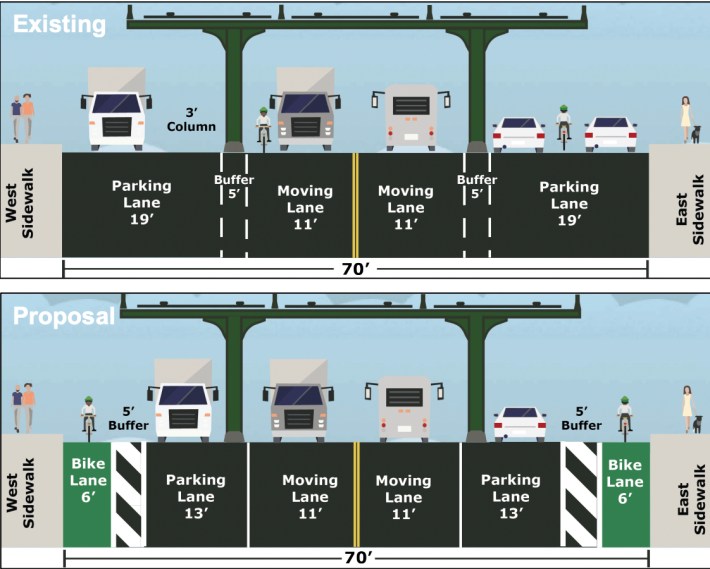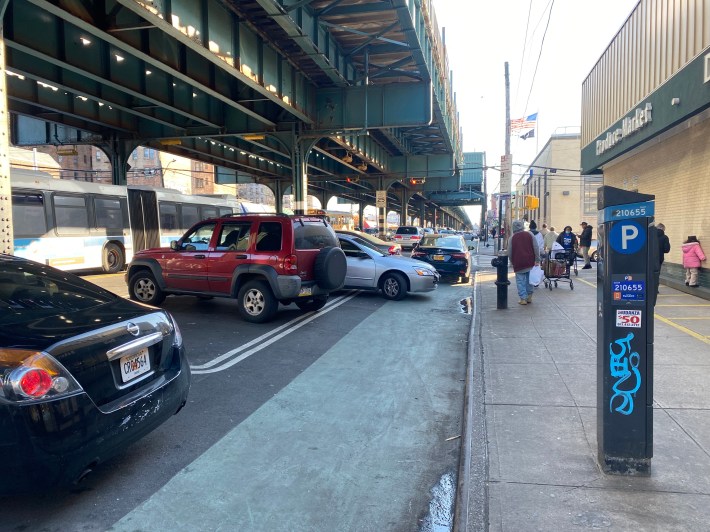The city will extend protected bike lanes on White Plains Road under the elevated 2 and 5 subway tracks one mile south to Pelham Parkway this summer, officials revealed earlier this month.
The project [PDF] continues work DOT began north of Burke Avenue in 2022 to organize the chaotic space under the elevated subway with intersection upgrades for pedestrians, bus boarding islands and protected bike lanes.
The earlier redesign marked the first time DOT ever installed protected lanes beneath an elevated subway track, according to agency officials.
“Where we’ve done this design, we are seeing more predictability,” DOT Director of Safety Projects and Programs Chris Brunson told Bronx Community Board 11's transportation committee on May 6. “This year we want to expand on the safety work, bringing the predictability, visibility, and mobility benefits further south to Pelham Parkway."

White Plains Road is one of the most dangerous streets in the Bronx, with a rate of 5.4 pedestrians killed or seriously injured per mile between 2017 and 2021, according to DOT data. The road is a DOT Vision Zero priority corridor.
The segment due for a redesign this summer, Burke Avenue to Pelham Parkway, saw a whopping 217 injuries in crashes between 2019 and 2023 — a rate of nearly five a month, DOT said. Half of all crashes with pedestrians were caused by drivers failing to yield while turning, which officials pin on the train track columns blocking sight lines.
Drivers use the space between the metal columns and the curb for both moving and parking, adding to the danger. People on bikes and e-scooters, which DOT has rolled out in that part of the borough, also use the space even though there’s no safe separation from car traffic, according to the agency.
DOT's redesign — already implemented from E. 241st Street to Burke Avenue — transforms the street's existing unruly 19-foot-wide parking/moving lanes on the outside of the elevated subway columns into 6-foot bike lanes protected from traffic by a 5-foot buffer and 13-foot parking plane.

Perhaps the worst indignity on the street is the bus stops, or lack thereof.
Riders on the Bx39 and BxM11 must board and get off in the middle of the roadway because the columns block buses from pulling up to the sidewalk. That means bus operators can’t lower their ramps for people in wheelchairs, pushing strollers, or with shopping carts — a violation of the Americans with Disabilities Act, officials said.
“It’s a big safety concern. Drivers and bus riders can be inches away from each other while they’re waiting for the bus,” Ben Schwed, assistant director with DOT's Research, Implementation and Safety Program, told board members.
DOT plans to install a concrete boarding island at Waring Avenue as part of this project, and another at Mace Avenue as part of a separate upgrade in 2026. The agency installed concrete boarding islands at six intersections in the previous two phases of the project up north.

The first phase north of Burke Avenue led to a 15 percent drop in injuries and a 10 percent increase in cycling, according to DOT. But that portion is still littered with illegal parking, Streetsblog found during a visit to the area last year.
DOT is working with Bronx CB 12 to make tweaks to the markings and add “vertical elements” to discourage illegal parking, DOT officials said.

Locals expressed gratitude for the changes, saying they fill one of many gaps in the borough's network of safe bike routes.
"One of the frustrating things about riding around the Bronx is that you get all these bike lanes to nowhere, that suddenly end, and then you’re in an unfriendly zone," said Diana Finch at the community board meeting.
"As a bike rider and a rental e-scooter rider, thank you, thank you, thank you."
However, the chair of Community Board 11's transportation committee — which previously opposed bus upgrades on Fordham Road, according to a local activist — declared he didn't "know too much about bicycles" and was skeptical of the safety benefits.
"I don’t know too much about bicycles, I know what they look like, but is that gonna stop a senior from running right in front of a speeding bicycle that goes 50 miles an hour, which I see all over this neighborhood," said Rabbi Moshe Fuchs.
Schwed acknowledged that more people with faster, motorized bikes now use the lanes, but noted that overwhelming death and destruction still wrought by drivers.
"It’s important to point out that the vast majority of the people getting injured on these streets are being, unfortunately, injured by drivers," the DOT rep said.
Protected bike lanes are actually especially good at making streets safer for seniors, according to DOT stats, having reduced the number of elders on foot killed or seriously injured in traffic by 39 percent where the city installed them, well above the 29 percent reductions for pedestrians generally.
"Where we have installed these bike lanes, we continue to see really substantial safety improvements for everybody using them," Schwed added.






